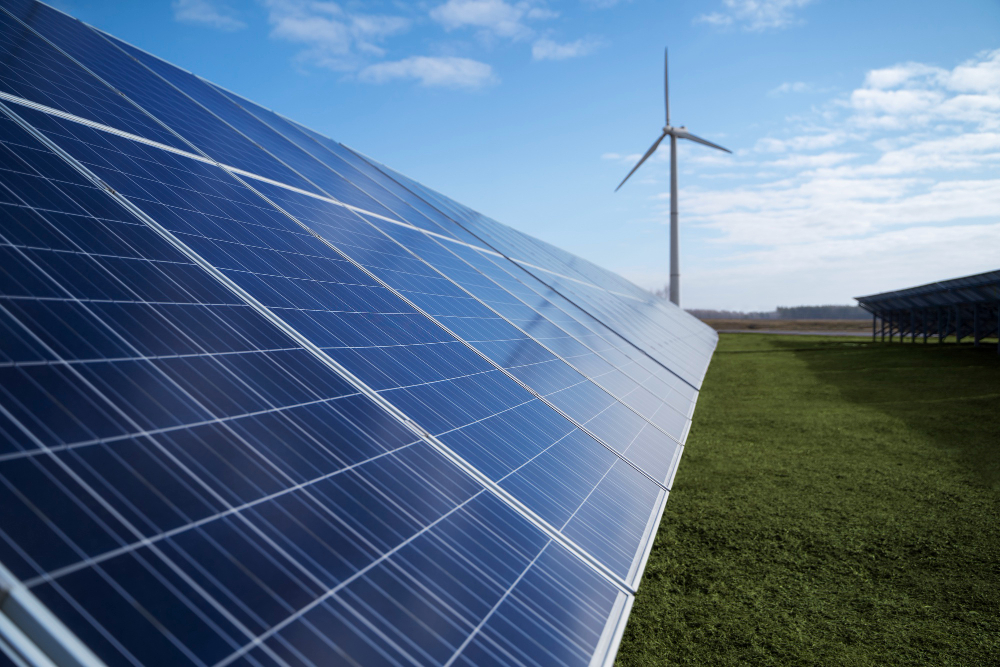India’s renewable energy sector has achieved a major milestone in the first half (H1) of 2025, with record generation from solar and wind power leading to a marked decline in fossil fuel use and power sector emissions, according to global energy think tank Ember.
Solar power output grew by 17 terawatt-hours (TWh) — a 25% rise compared with H1 2024 — lifting its share in total electricity generation to 9.2% from 7.4% last year. Wind generation also saw strong momentum, climbing 29% (11 TWh) to account for 5.1% of India’s power mix. Nuclear energy output increased by 14%, while hydropower rebounded 17% after a dip in 2024.
This surge in clean generation pushed coal-based power down by 22 TWh (3.1%) and gas-based power by 34%, resulting in an estimated 24 million tonnes reduction in carbon dioxide emissions compared with the same period last year.
Subdued Demand, Strong Renewable Response
Electricity demand in India grew only 1.3% in H1 2025 — the slowest pace since the pandemic — due to milder temperatures, lower industrial activity, and reduced cooling demand, the Ember report noted. Air conditioners alone account for nearly one-fifth of India’s total power consumption.
Despite this moderate growth, renewables met almost all incremental electricity needs, sharply reducing dependence on fossil fuels. Ember expects demand to pick up in the second half of 2025, potentially increasing coal use slightly, but reaffirmed that solar, wind, hydro, and nuclear will remain the main drivers of India’s clean energy transition.
Global Context: India Closes In on China’s Lead
According to the International Energy Agency (IEA) in its Renewables 2025 report released on October 7, India is set to become the second-largest renewables growth market globally, after China. The IEA projects that global renewable power capacity will expand by 4,600 gigawatts (GW) by 2030 — equivalent to the combined generation capacity of China, the European Union, and Japan.
The expansion is led by solar photovoltaic (PV) systems, expected to contribute nearly 80% of total global growth, driven by lower technology costs, faster permitting, and strong policy support.
Solar Dominates the Global Transition
IEA Executive Director Fatih Birol said that solar PV would continue to dominate global renewable expansion in the coming years. “Solar is on course to account for four-fifths of the growth in renewable capacity over the next five years, with wind, hydropower, and geothermal energy also playing vital roles,” he stated.
He added that alongside established markets like Europe and China, emerging economies such as India, Saudi Arabia, Pakistan, and Southeast Asia are witnessing rapid solar growth supported by new policy frameworks and renewable energy auctions.
Policy Shifts Shape the Outlook
The IEA report slightly revised its global growth outlook downward compared to last year, citing policy shifts in China and the United States. The phasing out of US federal tax incentives and China’s transition from fixed tariffs to auctions have slowed growth expectations in both markets.
Conversely, India, Europe, and other emerging economies have recorded upward revisions in renewable forecasts due to expanded auction schemes, faster approvals, and increased rooftop solar installations.
Corporate Confidence and Supply Chain Challenges
Major renewable energy developers worldwide have maintained or even raised their 2030 deployment targets, reflecting sustained confidence in the sector despite financial pressures and supply chain bottlenecks. Offshore wind remains a weak spot, with a 25% lower growth outlook compared with last year, mainly due to cost inflation and logistical hurdles.
The IEA also highlighted ongoing supply chain concerns — over 90% of global solar PV and rare earth processing remains concentrated in China — emphasizing the need for diversification and investment in local manufacturing to ensure long-term energy security.
India’s Path to 2030: Green Growth and Global Relevance
With renewable capacity expanding across all fronts, India remains on track to meet its 2030 target of 500 GW of non-fossil fuel energy capacity and to cut emissions intensity by 45%. The sharp rise in solar and wind generation, along with gains in hydro and nuclear power, positions India as a pivotal force in the global clean energy transformation.
Experts note that India’s continued leadership in renewables will depend on sustained grid modernization, storage infrastructure, and policy coherence — but the trajectory remains clear: a greener, more self-reliant energy future is already taking shape.



